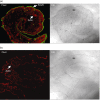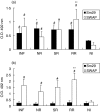Human antibody responses of patients living in endemic areas for schistosomiasis to the tegumental protein Sm29 identified through genomic studies
- PMID: 16734606
- PMCID: PMC1941986
- DOI: 10.1111/j.1365-2249.2006.03081.x
Human antibody responses of patients living in endemic areas for schistosomiasis to the tegumental protein Sm29 identified through genomic studies
Abstract
Surface proteins of schistosomes are exposed to host tissues and thus present as potential candidate molecules for the development of new intervention strategies. Herein, we have identified a new tegumental protein of Schistosoma mansoni, termed Sm29. In silico analysis revealed a signal peptide, three glycosylation sites and a transmembrane region on Sm29 amino acid sequence. Sm29 transcription in mammalian developmental stages cDNA libraries of S. mansoni was verified by PCR using specific primers for Sm29 nucleotide sequence and it revealed the presence of transcripts in schistosomula and adult worm stages of the parasite. Sm29 (40-169) fragment was produced in Escherichia coli and purified by affinity chromatography to be used in the immunological assays. Confocal microscopy confirmed bioinformatic studies, revealing that Sm29 is a membrane-bound protein localized on the tegument of S. mansoni adult worm. ELISA was performed using rSm29 protein to investigate the antibody isotype profile to Sm29 in sera of patients living in endemic areas for schistosomiasis. IgG1 and IgG3 subclass antibodies to rSm29 were predominant in sera of individuals naturally resistant to infection and resistant to re-infection whereas low levels of IgM, IgA or IgE were measured. Since, IgG1 and IgG3 are involved in parasite killing and in protective immunity the findings reported here suggest the use of Sm29 as a potential candidate vaccine against schistosomiasis.
Figures






References
-
- van der Werf MJ, de Vlas SJ, Brooker S, Looman CW, Nagelkerke NJ, Habbema JD, Engels D. Quantification of clinical morbidity associated with schistosome infection in sub-Saharan Africa. Acta Trop. 2003;86:125–39. - PubMed
-
- Harder A. Chemotherapeutic approaches to schistosomes. current knowledge and outlook. Parasitol Res. 2002;88:395–7. - PubMed
-
- Bergquist NR. Schistosomiasis vaccine development: approaches and prospects. Mem Inst Oswaldo Cruz. 1995;90:221–7. - PubMed
-
- Bergquist NR. Schistosomiasis vaccine development. Prog Prospects Mem Inst Oswaldo Cruz. 1998;93:95–101. - PubMed
Publication types
MeSH terms
Substances
LinkOut - more resources
Full Text Sources
Other Literature Sources
Miscellaneous

